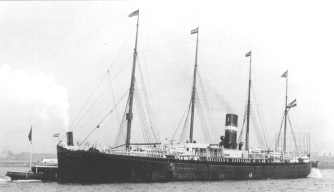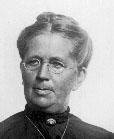The further back one traces a family, the murkier the waters become. If it isn’t poor record-keeping, it’s a courthouse fire. And that’s if it isn’t wishful thinking on the part of another family researcher. Still most legends have some basis in fact. What then, is the basis of the fantastic legend surrounding the emigration of Mark Anthony?
The most traditional version of the narrative is that Mark Anthony was born in about 1670 to a merchant of the same or a similar name in Genoa, Italy. The elder Mark Anthony (or Marcus Antony, as he is sometimes known to researchers, most likely to distinguish him from his son) relocated to the Netherlands for reasons that aren’t clear. He desired his son to be educated in Genoa — an idea that didn’t appeal to the younger Mark Anthony’s adventurous spirit at all. Instead, the young man ran away to sea. He was waylaid by Barbary pirates and enslaved in Algiers. Different versions vary in the details, but most agree that once in Algiers, Mark Anthony either escaped by killing his captor or simply by slipping away. This story was retold for generations, and it seemed especially strong in the Georgia Anthony branch of the family.
Arlene Anthony, a researcher associated with Linda Starr’s Colonial Virginia Connections group, does not believe this wild tale, and I have to admit I don’t either. Her research tends to suggest that the Anthony family were from England, possibly by way of the Iberian peninsula, and that they were either Jewish or Roma. I think it more likely that they were Jewish. Their movements mirror those of Marranos, though without historical documents, it is impossible to know exactly when the family migrated from Italy or the Iberian Peninsula to the Netherlands.
The Georgia account of Mark Anthony’s arrival indicates that he arrived in Virginia after his harrowing adventure before October 3, 1690 and was indentured (possibly to Charles Fleming) for three years in order to pay for his passage. He is one of twenty people listed in an application for a land patent of 1000 acres in New Kent County in 1690. In 1700, he applied for a land grant of 1000 acres — some researchers speculate he returned to Europe and brought back 20 applicants in order to apply for this land grant. The 1704 book of Quit Rents indicates he had 190 acres of land in New Kent County. He appears in the records of St. Paul’s Vestry in 1709.
Mark Anthony married Isabella Hart in about 1703 and become a prosperous landowner. Some family researchers believe that the Anthonys and allied families were Crypto-Jews because they continued to practice Sephardic naming traditions. I have not found this to be true. Strict Sephardic naming practices call for the first son to be named for his paternal grandfather and the first daughter for her paternal grandfather. The second son and daughter should be named for the maternal grandfather and grandmother, respectively. The third son/daughter should be named for a paternal uncle or aunt, and the fourth son/daughter for a maternal uncle or aunt. The Clarks and Anthonys did commonly “recycle” names across generations in a somewhat Sephardic fashion, but it is not exact. For example, Mark Anthony’s son Joseph Anthony and his wife Elizabeth Clark Anthony did not name their firstborn son Mark — rather, he was named Christopher for his wife’s father. Likewise, their first daughter was named Sarah, seemingly for a maternal aunt. Not until their sixth son was born would they name him for his paternal grandfather, Mark Anthony. It is possible that the family were indeed Sephardic in origin, but I don’t think one can use their naming practices as evidence.
The Anthony family married into the Quaker families of Colonial Virginia. While Quakers would probably have been more tolerant of Jews, and thus, might have married Jews, it appears that if the Anthonys were Jewish, they eventually adopted various forms of Quaker or Protestant faith. For example, Anselm Anthony, a great-grandson of Mark Anthony, was a renowned Baptist minister in Georgia. Mark Anthony’s daughter-in-law, Elizabeth Clark Anthony, was known to have made multiple missionary trips between Georgia and Virginia; her family were said to be devoted Quakers. A funny and almost certainly apocryphal story has been passed down in the Anthony family that suggests that Joseph Anthony, son of Mark, actually possessed a written genealogy of his descent from Mark Antony, the famous Roman general and politician. His pious in-laws supposedly burned the document because it bespoke vanity. (I wonder what they would make of their numerous genealogist descendants!)
Speculation about who Mark Anthony might have been is more abundant than actual evidence. Certainly, he was the progenitor of a family of colorful characters with a love for a good yarn. You can read more about my own speculations (a post which also recounts my ancestry traced back to Mark Anthony) as to his background and you can read those of Arlene Anthony at Colonial Virginia Connections.
This post is third in a series about my known immigrant ancestors.

 In my
In my 
 Aaljte Zwier (left) was born in
Aaljte Zwier (left) was born in  My great-grandfather Herman Cunningham, kept a diary of sorts during his tenure in the U.S. Army in World War I. My Aunt Carolyn, Herman Cunningham’s youngest daughter, sent me the following. Note: I’m not sure if this is the entire diary or an excerpt.
My great-grandfather Herman Cunningham, kept a diary of sorts during his tenure in the U.S. Army in World War I. My Aunt Carolyn, Herman Cunningham’s youngest daughter, sent me the following. Note: I’m not sure if this is the entire diary or an excerpt.